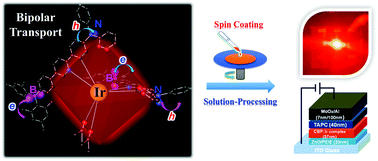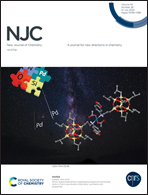Two novel neutral and ionic Ir(iii) complexes based on the same bipolar main ligand: a comparative study of their photophysical properties and applications in solution-processed red organic light-emitting diodes†
Abstract
Using 4-(5-(4-(dimesitylboranyl)phenyl)pyridin-2-yl)-N,N-diphenylaniline (BNpppy) as a cyclometalated ligand, 1,10-phenanthroline or 2,4-pentanedione (acac) as the ancillary ligand, respectively, two novel iridium(III) complexes (Ir-1 and Ir-2) were successfully synthesized and their photoelectric properties have been investigated in detail. The incorporation of electron-accepting dimesitylboron (Mes2B) moieties and electron-donating triphenylamine moieties into iridium(III) complexes has been demonstrated with benign photophysical and electronic properties. The solution-processed OLEDs were fabricated using these two iridium(III) complexes, respectively. The devices of Ir-2 show good performances compared to those of Ir-1 with a maximum luminance of 7916 cd m−2, a maximum external quantum efficiency (EQE) of 2.48% and a maximum current efficiency of 3.99 cd A−1. These results indicate that the introduction of a donor–acceptor type of ligand into transition metal complexes has potential applications in constructing an efficient emitter in OLEDs with excellent performances.



 Please wait while we load your content...
Please wait while we load your content...